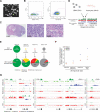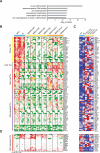An aberrant transcription factor network essential for Wnt signaling and stem cell maintenance in glioblastoma
- PMID: 23707066
- PMCID: PMC3774301
- DOI: 10.1016/j.celrep.2013.04.021
An aberrant transcription factor network essential for Wnt signaling and stem cell maintenance in glioblastoma
Abstract
Glioblastoma (GBM) is thought to be driven by a subpopulation of cancer stem cells (CSCs) that self-renew and recapitulate tumor heterogeneity yet remain poorly understood. Here, we present a comparative analysis of chromatin state in GBM CSCs that reveals widespread activation of genes normally held in check by Polycomb repressors. These activated targets include a large set of developmental transcription factors (TFs) whose coordinated activation is unique to the CSCs. We demonstrate that a critical factor in the set, ASCL1, activates Wnt signaling by repressing the negative regulator DKK1. We show that ASCL1 is essential for the maintenance and in vivo tumorigenicity of GBM CSCs. Genome-wide binding profiles for ASCL1 and the Wnt effector LEF-1 provide mechanistic insight and suggest widespread interactions between the TF module and the signaling pathway. Our findings demonstrate regulatory connections among ASCL1, Wnt signaling, and collaborating TFs that are essential for the maintenance and tumorigenicity of GBM CSCs.
Copyright © 2013 The Authors. Published by Elsevier Inc. All rights reserved.
Figures





Similar articles
-
Wnt activation promotes neuronal differentiation of glioblastoma.Cell Death Dis. 2013 Feb 21;4(2):e500. doi: 10.1038/cddis.2013.32. Cell Death Dis. 2013. PMID: 23429286 Free PMC article.
-
Regulation of glioblastoma multiforme stem-like cells by inhibitor of DNA binding proteins and oligodendroglial lineage-associated transcription factors.Cancer Sci. 2012 Jun;103(6):1028-37. doi: 10.1111/j.1349-7006.2012.02260.x. Epub 2012 Apr 4. Cancer Sci. 2012. PMID: 22380883 Free PMC article.
-
ASCL1 Reorganizes Chromatin to Direct Neuronal Fate and Suppress Tumorigenicity of Glioblastoma Stem Cells.Cell Stem Cell. 2017 Aug 3;21(2):209-224.e7. doi: 10.1016/j.stem.2017.06.004. Epub 2017 Jul 14. Cell Stem Cell. 2017. PMID: 28712938
-
Deciphering the role of transcription factors in glioblastoma cancer stem cells.Acta Biochim Biophys Sin (Shanghai). 2024 May 8;56(9):1245-1255. doi: 10.3724/abbs.2024061. Acta Biochim Biophys Sin (Shanghai). 2024. PMID: 38716541 Free PMC article. Review.
-
Impact of WNT signaling on tissue lineage differentiation in the early mouse embryo.Dev Growth Differ. 2011 Sep;53(7):843-56. doi: 10.1111/j.1440-169X.2011.01292.x. Epub 2011 Jul 15. Dev Growth Differ. 2011. PMID: 21762130 Review.
Cited by
-
The role of glioma stem cells in chemotherapy resistance and glioblastoma multiforme recurrence.Expert Rev Neurother. 2015;15(7):741-52. doi: 10.1586/14737175.2015.1051968. Epub 2015 May 31. Expert Rev Neurother. 2015. PMID: 26027432 Free PMC article. Review.
-
Tumoricidal stem cell therapy enables killing in novel hybrid models of heterogeneous glioblastoma.Neuro Oncol. 2019 Dec 17;21(12):1552-1564. doi: 10.1093/neuonc/noz138. Neuro Oncol. 2019. PMID: 31420675 Free PMC article.
-
Glioblastoma cells vampirize WNT from neurons and trigger a JNK/MMP signaling loop that enhances glioblastoma progression and neurodegeneration.PLoS Biol. 2019 Dec 17;17(12):e3000545. doi: 10.1371/journal.pbio.3000545. eCollection 2019 Dec. PLoS Biol. 2019. PMID: 31846454 Free PMC article.
-
A high-throughput screening and computation platform for identifying synthetic promoters with enhanced cell-state specificity (SPECS).Nat Commun. 2019 Jun 28;10(1):2880. doi: 10.1038/s41467-019-10912-8. Nat Commun. 2019. PMID: 31253799 Free PMC article.
-
Cancer stem cells in glioma: challenges and opportunities.Transl Cancer Res. 2013 Oct 1;2(5):429-441. doi: 10.3978/j.issn.2218-676X.2013.08.01. Transl Cancer Res. 2013. PMID: 24634854 Free PMC article.
References
-
- Bao S, Wu Q, McLendon RE, Hao Y, Shi Q, Hjelmeland AB, Dewhirst MW, Bigner DD, Rich JN. Glioma stem cells promote radioresistance by preferential activation of the DNA damage response. Nature. 2006;444:756–760. - PubMed
-
- Barde I, Salmon P, Trono D. Production and titration of lentiviral vectors. Curr Protoc Neurosci. 2010 Chapter 4, Unit 4 21. - PubMed
-
- Bell O, Tiwari VK, Thoma NH, Schubeler D. Determinants and dynamics of genome accessibility. Nat Rev Genet. 2011;12:554–564. - PubMed
Publication types
MeSH terms
Substances
Associated data
- Actions
Grants and funding
LinkOut - more resources
Full Text Sources
Other Literature Sources
Molecular Biology Databases
Miscellaneous

